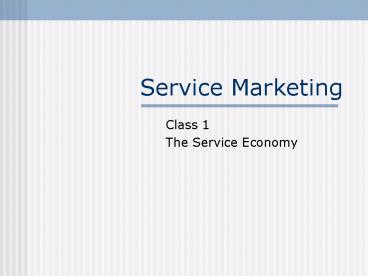Service Marketing - PowerPoint PPT Presentation
1 / 17
Title:
Service Marketing
Description:
In the USA--world's largest economy--services account for 73% of GDP and 76% of jobs ... behind the scenes (reengineering, new value chains) ... – PowerPoint PPT presentation
Number of Views:16
Avg rating:3.0/5.0
Title: Service Marketing
1
Service Marketing
- Class 1
- The Service Economy
2
Chapter 1
- Distinctive Aspects of
- Service Management
3
What is a Service? Defining the Essence
- An act or performance offered by one party to
another. (Performances are intangible, but may
involve use of physical products.) - An economic activity that does not result in
ownership - A process that creates benefits by facilitating a
desired change in customers themselves, physical
possessions or intangible assets
4
The Service Sector
- Includes businesses, government agencies,
nonprofits - Jobs range from high-paid professionals and
technicians to minimum-wage positions - Service organizations can be any size--from huge
global corporations to local small businesses - In most countries, adds more economic value than
agriculture, raw materials and manufacturing
combined - In the USA--worlds largest economy--services
account for 73 of GDP and 76 of jobs
5
Fig. 1.1 GDP by Industry in the USA, 1997
Services vs. Manufacturing, Govt., Agriculture,
etc.
Other Services
1,399
Data in billions of 1992 constant dollars
Transportation, Communications, Utilities
644
1,286
Finance, Insurance, Real Estate
Wholesale and Retail Trade
1,246
1,370
861
512
Services
Govt. (mostly services)
Agriculture, Mining, Construction
Manufact- uring
Source Bureau of Economic Analysis, September
1999
6
Changing Structure of Employment with Economic
Development
Share of Employment
Time, per Capita Income
Source CIA World Factbook
7
Value Added by Services in Selected European
Countries 1994 vs. 1960 (Table 1.1)
- Ireland - 83 vs. 52
- France - 70 vs. 50
- Netherlands - 70 vs. 45
- Denmark - 69 vs. 58
- Swede - 68 vs. 53
- UK - 66 vs. 54
- Austria - 64 vs. 42
- Finland - 63 vs. 48
- Hungary - 60 (n.a.)
- Italy - 60 vs. 47
- Czech Rep. - 55 (n.a.) (pre partition)
8
Some Industries in the Service Sector
- Banking, stockbroking
- Lodging
- Restaurants, bars, catering
- Insurance
- News and entertainment
- Transportation (freight and passenger)
- Health care
- Education
- Wholesaling and retailing
- Laundries, dry cleaning
- Repair and maintenance
- Professional (e.g., law, architecture,
consulting)
9
Internal Services
- Service elements within an organization that
facilitate creation of--or add value to--its
final output - Includes
- accounting and payroll administration
- recruitment and training
- legal services
- transportation
- catering and food services
- cleaning and landscaping
- Increasingly, these services are being outsourced
10
Basic Differences between Goods and Services
(Table 1.2)
- Customers do not obtain ownership of services
- Service products are intangible performances--not
objects - Customers often actively involved in production
process - Other people may form part of product experience
11
Basic Differences between Goods and Services
(Table 1.2)
- More variability in operational inputs and
outputs--harder to improve productivity, control
quality - Often difficult for customers to evaluate
- Absence of inventories after production
- Time factor is more important--speed may be key
- Delivery systems include electronic and physical
channels
12
Fig. 1.4 Dominance of Tangible and Intangible
Elements in Goods and Services
Hi
Salt
Soft drinks
VCR
Tennis Racquet
New Car
Custom-clothing
Furniture Rental
Fast Food Restaurant
Tangible Elements
Plumbing Repair
Lawn Care
Oil Change on Car
House Cleaning
Airline Flight
Teaching
Investment Advice
Lo
Intangible Elements
Hi
13
Figure 1.5 The 8Ps of Integrated Service
Management
- Product elements
- Place, cyberspace, and time
- Process
- Productivity and quality
- People
- Promotion and education
- Physical evidence
- Price and other user costs
14
Fig. 1.6 Interdependence of Marketing,
Operations and Human Resources
Operations
Marketing
Management
Management
Customers
Human
Resources
Management
15
Factors Stimulating Competition and Innovation in
the Service Economy (Fig. 1.7)
- Government Policies (e.g., regulations, trade
agreements) - Social Changes (e.g., affluent, time poor, seek
experiences) - Business Trends
- Manufacturers offer service
- Growth of chains and franchising
- Pressures to improve productivity and quality
- More strategic alliances
- Marketing emphasis by nonprofits
- Innovative hiring practices
16
Factors Stimulating Competition and Innovation in
the Service Economy (Fig. 1.7)
- Advances in IT (e.g., speed, digitization,
wireless, Internet) - Internationalization (travel, transnational
companies)
17
Some Impacts of Technological Change
- Radically alter ways in which service firms do
business - with customers (new services, more convenience)
- behind the scenes (reengineering, new value
chains) - Create relational databases about customer needs
and behavior, mine databanks for insights - Leverage employee capabilities and enhance
mobility - Centralize customer service, be faster and more
responsive - Develop national/global delivery systems
- Create new, Internet-based business models































